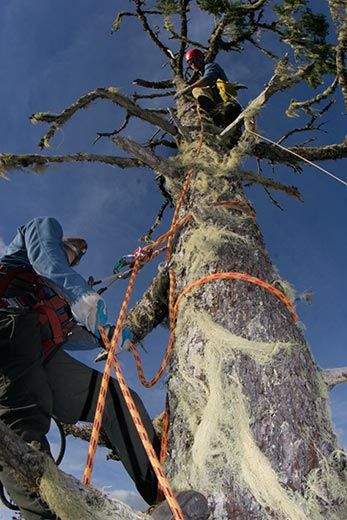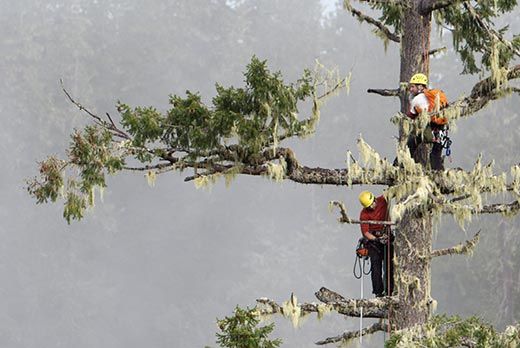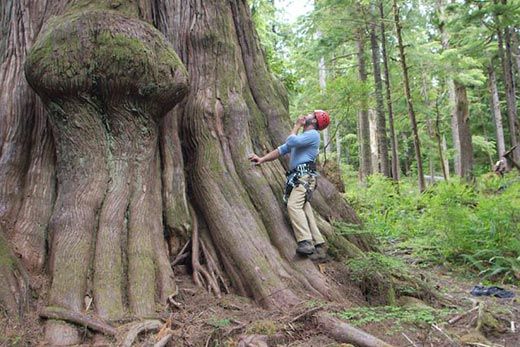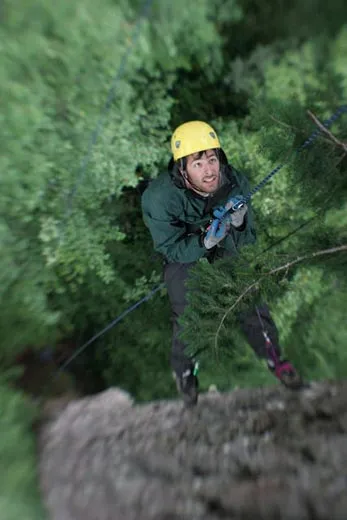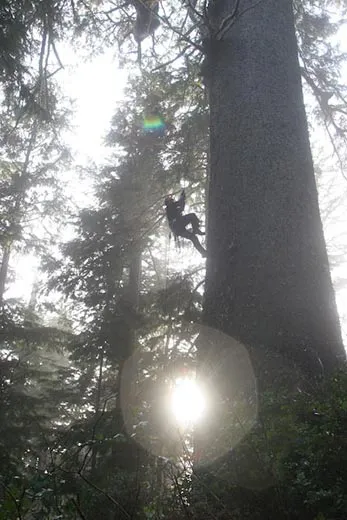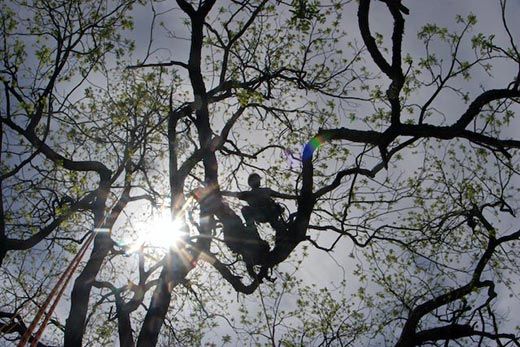Climbing the Tallest Trees
A select group of adventurers climb the world’s tallest trees to learn more about the wildlife that lives on the highest branches
/https://tf-cmsv2-smithsonianmag-media.s3.amazonaws.com/filer/climbers-ascending-National-Champion-Douglas-Fir-Oregon-631.jpg)
“Watch out! Boomer hole!” someone shouted, and I narrowly avoided twisting my ankle in the burrow of a mountain beaver. These primitive rodents, nicknamed for the booming grunts they produce, have dug a network of tunnels through this patch of old-growth forest that would be the envy of any World War I general. After a treacherous two-hour march along steep elk trails near the Siuslaw National Forest in Oregon, our eight-person group reached base camp like so many exhausted pack mules. With only a few hours of sunlight left, we set to work immediately. One man loaded a bolt into his crossbow and took aim—not at the rodents below, but at the giants that surrounded us.
The bolt, with 30-pound-test fishing line attached, sailed up and over the canopy of the imposing 266-foot-tall tree in front of us. After a few more volleys, it crossed over a high, sturdy limb. Using knots worthy of a Boy Scout—a clove hitch and a few half hitches—another member of the team attached a lightweight rope to the fishing line. This rope was pulled over the limb and used in turn to pull up the 600-foot-long climbing rope.
As four men struggled together to pull the climbing rope over the giant tree, I couldn’t get the image out of my head of Lilliputians trying to tie down Gulliver—this can only end in tragedy. But these professional arborists approached the challenge with steady arms and clear minds. Members of the group Ascending the Giants (ATG), they climb some of the tallest trees on the planet to document them and the plants and animals they harbor.
That evening, I took off my mud-caked boots and slipped into my "tree boat," a specialized hammock used to sleep in tree canopies. Four members of the ATG team took off their arborist helmets and slipped into their respective tree boats. The only difference was that while I was sleeping five feet above the ground, they were roughly 200 feet up. The next morning, I ate a Clif Bar near my backpack and watched the modern-day Tarzans as they cooked food in their hammocks above. One of ATG’s founding members, Will Koomjian, rappelled down and crossed the fallen, moss-laden tree that served as our bridge over the clear water of Wassen Creek. Reading my thoughts, he asked nonchalantly, “Hey, you want to give it a try?”
I saddled up, stepping into a harness and attaching foot and arm ascenders to the rope. The ascenders are climbing tools that move up a rope but cannot move down—for good reason. I was given a crash course on tree climbing. Push down on feet ascenders, push up with arm ascenders, stick your butt out and rest. This was no place for vanity. I stared up the mostly naked tree trunk and ran my eyes higher and higher along the black rope until it blended with the branches above. I squirmed up the trunk for 100 vertical feet or so, and was finally high enough to catch the sunlight that was obscured by the canopy.
When I paused, I saw two inchworms hanging from strands of silk attached to a sun-kissed branch. The absurdity of dangling from a single rope far above the ferns below was put into perspective quickly. These minuscule creatures braved these heights naturally; they were part of the tree. My fascination with this special place grew with each push. The remaining 100 feet went by in a blur.
Up in the branches of this goliath, I felt the tree sway back and forth with the wind, an unsettling sensation. From the ground, the nine-foot-wide tree almost seemed sturdy enough to support the earth below it and not the other way around. But from my precarious vantage point in the canopy, I spied a forest floor littered with fallen giants.
“Oh, it’s at least 500 years old; it’s been through plenty of storms," said ATG co-founder Brian French, in an offhand attempt to both reassure and terrify me as we chatted 200 feet up in the tree. "Of course, I could be wrong.” We shot the breeze some more, and as the musk of ancient fir and moss wafted into my nostrils, I was reminded that this is a living organism.
Ascending the Giants, founded in 2007 by French and Koomjian, documents the largest, so-called “champion” trees of a given species. The group is a mix of certified arborists, a canopy biologist, a professional photographer and a filmmaker. They use the strict measuring guidelines of the American Forest Point system and register the trees they study with the National Register of Big Trees (for national champions) and various state registries (for state champions). Often the trees ATG studies are the largest of their kind in the world. The registries encourage people to nominate any large trees they come across, but above all they value accurate measurements to establish what are truly the largest specimens.
The interest in super-sized trees has helped ATG disseminate its findings and educate the public about the importance of old-growth trees and their peculiar, sensitive ecosystems. Though the group's primary mission is to document the existence of possible champion trees and to update official records, it also studies the fascinating and rare species that favor old-growth forests.
It is possible to measure trees with laser range-finders, but precise instruments cost thousands of dollars and resemble clunky TV cameras from the 1980s—not ideal equipment to haul into a remote old-growth forest. As a result, climbing the trees and measuring them with a simple fishing line dropped to the ground is the most effective way to officially measure a tree.
As with any superlative, there is often conflict and competition over the title of largest tree. Oregonians recently mourned the loss of the “Klootchy Creek Giant,” blown down in a storm in 2007. It was the national co-Champion Sitka Spruce, and now Washington State proudly holds the exclusive Champion Sitka title for one of its trees. There was a certain amount of playful bitterness expressed toward Washington on Oregon's radio programs and blogs in the months following the demise of Oregon's green giant.
Bill Price, a nature-loving banker cum firefighter who is now retired, volunteers to help ATG study arboreal fauna. The second day after we arrived at the study site, he spotted bird droppings—globs of dried, white goop—on a fern near the base of one of the giants. His bright blue eyes lit up. To be inspired by feces is a rare event, but in this case it was well justified. Where there are droppings, there are animals. We spent the better part of the day trying to fix a rope to the tree in question to look for a possible Northern spotted owl nest. After several unsuccessful attempts to shoot a bolt over a sturdy limb that would allow us a view of the nesting cavity, we were bested. Price makes note of what the group finds in the trees and collects fecal and nesting samples, such as pine needles and bits of feathers or fur, to send to his colleagues for further study.
One of the scientists who analyze ATG's samples is Eric Forsman, a spotted owl expert and U.S. Forest Service biologist who is based at Oregon State University. He has been studying these old-growth forests for more than 40 years. He told me later, “we cannot duplicate the historic conditions that lead to old growth development ... they’re gone. [These forests], they are storehouses of biodiversity.” According to the conservation group Cascadia Wildlands Project, roughly 92 percent of Oregon’s historical old-growth forests have been logged. The conservation group is trying to get federal wilderness protection for Wassen Creek, the area where I accompanied ATG.
(Loggers are not to blame for all felled trees, however. In the summer of 2007, a woman near Clatskanie, Oregon, cut down the champion Pacific Dogwood tree, 65 feet tall and 5 feet in diameter. It was on her property and looked sickly. A neighbor told her it had a virus. Only later did she realize that she had cut down what represented the zenith of that species. One thing that motivates the ATG team is the malign influence of ignorance.)
Not far from the trees ATG is studying, broad swaths of clear cut formed a no man's land in what was once covered in old-growth forest. From up in the tree we ascended on this trip, though, team member Damien Carré pointed out cheerfully, “This really is a great view. Sometimes, when we’re in these trees, all we can see is clear cut in the horizon.”
An entire mysterious world exists far above the ground. In one of the trees the team rigged, Koomjian found the nest of a red tree vole and Price collected samples of its feces to send to Oregon State University. The red tree vole, a small, copper-hued rodent, spends its entire life in the canopy, the only vole to do so. To help quench its thirst, it licks up water from the condensation that forms on tree needles. (This condensation, incidentally, increases precipitation on the forest floor by 30 percent.) The needles are also the sole food source for the vole. Its feces provide nutrients and bacteria in the canopy. They also give off heat. This combination of heat and nutrients attracts insects, which in turn attract predators like the clouded salamander. On a previous expedition, Price found a male and female clouded salamander—at a record 300 feet high in a massive Douglas fir.
I survey the tree tops from the canopy one last time before descending to the fern-covered ground below. I spin slowly as I descend and my mind spins too, reflecting on these tree climbers' mission and the giants they ascend. My fascination with this special place grows with each foot of elevation lost. These trees are the keystones to many more things. From quixotic inchworms to industrious red tree voles, all find a place somewhere in the tree. And then, before I know it, my feet touch the moist, dark earth.
